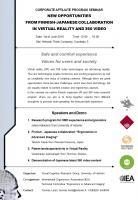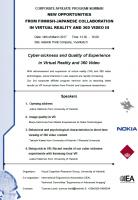Background
The year of 2010 is called the “3D First Year”. That is because 2010 is the year when the movie “Avatar (20th Century Fox, 2009)” set a world record of box office and also when there was the surge of the screens designed for the stereoscopic (3D) images internationally. The “3D First Year” is also the year when the social concern for the impact on the 3D users has come to be recognized apparently, because at that time major manufacturers have released their new 3D televisions and games one after another to the market. In other words, it may be said that 2010 was the year when the needs for the ergonomic knowledge on 3D has increased.
In addition to 3D, practical use of advanced imaging technologies, such as VR (Virtual Reality), UHD (Ultra High Definition), HDR (High Dynamic Range), has been rapidly expanding in recent years. Along with this, provisions of ergonomic knowledge on advanced imaging are expected from industry such as manufacturers and content creators.
Objectives
To increase ergonomic knowledge for creation and application of advanced imaging content and system
To construct ergonomic guidelines for safe and comfort use of advanced imaging technologies
To bridge ergonomic knowledge and researchers with industries and professionals all over the world in terms of advanced imaging
To promote industry-academia collaboration such as advanced imaging system design / content creation utilizing ergonomic knowledge
Domains of Interest
Ergonomic knowledge on advanced imaging such as physical, physiological, psychological, cognitive, experiential, expressive and social characteristics
Practical application of ergonomic knowledge for system / content using advanced imaging technologies such as 3D, VR, UHD, HDR
Organizational Structure
The Technical Committee is a peer group of researchers, practitioners and educators without a hierarchical substructure.
International Collaborators
References
Kawai, T., Atsuta, D., Tomiyama, Y., Kim, S.H., Morikawa, H., Mitsuya, R. & Häkkinen, J., (2014) Disparity modifications and the emotional effects of stereoscopic images, SPIE, 9011, pp.901115-1-8.
Mustonen, T., Berg, M., Kaistinen, J., Kawai, T. & Häkkinen, J., (2013) Visual task performance using a monoclular see-through head-mounted display (HMD) while walking, Journal of Experimental Psychology, 19(4), pp.333-344.
Pölönen, M., Salmimaa, M., Takatalo, J. & Häkkinen, J. (2012) Subjective experiences of watching stereoscopic Avatar and U2 3D in a cinema. Journal of Electronic Imaging, 21(1), pp.011006-1-8.
Toyosawa, S., Kawai, T., Chen, C.S. & Lin, M.H. (2012) Differences in viewing history affect discomfort associated with stereoscopic video, Journal of the Society of Information Display, 28(8), pp.474-483.
Takatalo, J., Kawai, T., Kaistinen, J., Nyman, G. & Häkkinen, J. (2011) User experience in 3D stereoscopic games, Media Psychology, 14(1), pp.387-414.
Kawai, T., Häkkinen, J., Oshima, K., Saito, H., Yamazoe, T., Morikawa, H. & Nyman, G. (2011) Psycho-physiological effects of head-mounted displays in ubiquitous use, SPIE, 7881, pp.788107-1-12.
Häkkinen, J., Kawai, T., Takatalo, J., Mitsuya, R. & Nyman, G. (2010) What do people look at when they watch stereoscopic movies?, SPIE, 7524, pp.75240E-1-10.
 |
Co-organized Seminars in 2016 1/2NEW OPPORTUNITIES FROM FINNISH-JAPANESE COLLABORATION IN VIRTUAL REALITY AND 360 VIDEO Part 1 Virtual reality (VR) and 360 video technologies are advancing rapidly. The new technologies enable immersive and exciting experiences as well as completely new ways of creating contents. Although there are great opportunities, there are also challenges, which stem from technology, but are equally related to content creation and ergonomics aspects. In this seminar we outline Finnish-Japanese VR and 360 video research program where our aim is to bring together experts from different disciplines to promote wide-spreading the best possible experience.Download PDF |
 |
Co-organized Seminars in 2016 2/2
NEW OPPORTUNITIES FROM FINNISH-JAPANESE COLLABORATION IN VIRTUAL REALITY AND 360 VIDEO Part 2 Making Quality VR Content from shooting to viewing Virtual reality (VR) and 360 video are not only about technology. Content is important. Although VR and 360 video are still at early stage, there would be empirical rules and tacit knowledges for making quality content. |
 |
Co-organized Seminars in 2017
NEW OPPORTUNITIES FROM FINNISH-JAPANESE COLLABORATION IN VIRTUAL REALITY AND 360 VIDEO Part 3 Cyber-sickness and Quality of Experience in Virtual Reality and 360 Video With advancement and expansion of virtual reality (VR) and 360 video technologies, social interests in user aspects are rapidly increasing. |
Action Plan
| Activities | Description | Responsible | Milestones /Timeline |
Deliverable /Timeline |
| Organize a joint session / workshop with potential collaborators in IEA 2018 Congress or other occasions | Planning session / workshop proposals | Chair and co-chair | According to specifications of congress / other occasions | 2016-2018 |





